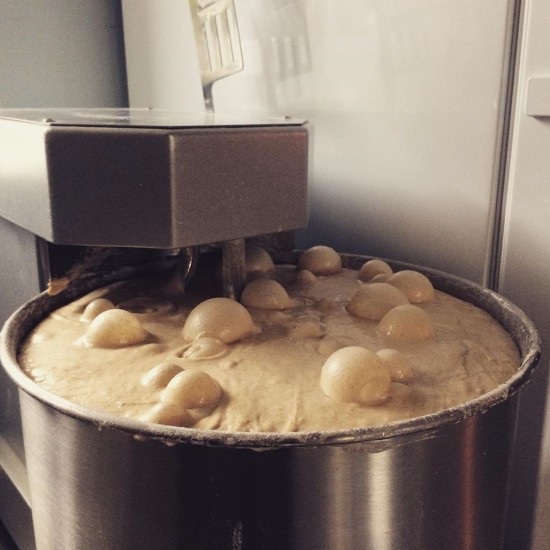I've seen several photos like these before, mainly on Instagram. This one came from a post by trianglebakehouse:

I can't say I ever get bubbles like that in my spiral mixer, but then it's a lot smaller and never as fully loaded.
I'm just wondering if these are air bubbles or CO2?
Any thoughts? Has anyone else ever experienced them?
Lance
I think they're air, and I think they're what happens when a sufficiently high-powered and high-speed mixer meets a sufficiently wet dough - the mixer whizzing through the dough as if to make whipped cream out of it, and raising air bubbles.
But knowing me, I'm likely to be wrong.
and pop the bubble. If the flame goes out it's CO2.
What ever you do, don't add baking soda!
Looks like they let the dough bulk rise in the mixer. And the bulk rise is finished. Most likely followed by a degassing and dough removal or a second bulk rise.
... If the flame expands greatly, it's oxygen. If the room explodes, it's hydrogen. And if you suddenly think you're waving that match at a concert, then it's probably butane or propane. ?
mixer dough and it is CO2.
that one of the experienced bakers on IG stated in his post that the emergence of bubbles show that the
dough is ready and mixing should be stopped...
I try to find this and might have saved somewhere in my folders on mixing...(although I don't have a mixer yet)...
I read it as the baker saying that it is a good sign for enough oxygyn in the dough and to stop mixing...
Just wanted to share but cannot add much more...Kat
and luckily my 'mixing' folder is not as full at the shaping folder...ha..ha....
https://www.instagram.com/p/BwKL6I0JHu3/?utm_source=ig_web_copy_link
and it is a post from Wayne Caddy and in the comments he explains that bubble appear when optimum mixing is achieved and that it is one of the ways he assesses if the dough is mixed enough.
Thanks Kat, but I'm afraid I don't think I'm any the wiser! I can't imagine these bubbles appear when you are actually mixing, so how do you know that you've gone far enough to know that they will appear when you stop?
Interesting that the comments echo my thoughts - ie bulking in mixer or very full mixer. I suspect it's to do with the latter, because they usually seem to be in IG posts were the baker is proudly displaying an impossibly full mixer, usually with a comment something like: "do you think I could have got a bit more in?". It must be a baker thing!
Lance
About the question of how you would know when to stop anyway: They wouldn't need to appear while you were literally still mixing, as long as they could be counted on to appear within a short time. (Short enough time that, if the bubbles failed to appear, you could just switch the mixer back on.)
Echoing Kat, I have heard Massari say this too - When bubbles appear under the skin of the dough this is a sign of optimal mixing.
As for the theses large bubbles. I have often seen them in panettone mixes.
I think surely it is the combination of good extensibility, good gluten development and a large mass of dough.
The weight of the dough exerts pressure compressing dough toward the bottom which forces air incorporated during mixing to rise up through the dough. Just like an air bubble rises up through water, except it collects at the surface and is trapped by the gluten matrix. That's what I think.
a result of good mixing. Cool.